List of Polish monarchs
 From Wikipedia - Reading time: 29 min
From Wikipedia - Reading time: 29 min
| Monarchy of Poland | |
|---|---|
 | |
 | |
| Details | |
| Style |
|
| First monarch |
|
| Last monarch | Stanislaus II Augustus |
| Formation | c. 960 (Duchy of Poland) |
| Abolition | 25 November 1795 |
| Residence | |
| Appointer | Hereditary[a] Elective |
| Pretender(s) |
|
Poland was ruled at various times either by dukes and princes (10th to 14th centuries) or by kings (11th to 18th centuries). During the latter period, a tradition of free election of monarchs made it a uniquely electable position in Europe (16th to 18th centuries).
The first Polish ruler whose existence is not debatable was Duke Mieszko I, who adopted Christianity under the authority of Rome in the year 966. He was succeeded by his son, Bolesław I the Brave, who greatly expanded the boundaries of the Polish state and ruled as the first king in 1025. The following centuries gave rise to the mighty Piast dynasty, consisting of both kings such as Mieszko II Lambert, Przemysł II or Władysław I the Elbow-high and dukes like Bolesław III Wrymouth. The dynasty's rule over Poland ceased with the death of Casimir III the Great in 1370. In the same year, the Capetian House of Anjou became the ruling house with Louis I as king of both Poland and Hungary. His daughter, Jadwiga, later married Jogaila, the pagan Grand Duke of Lithuania, who in 1386 was baptized and crowned as Władysław II Jagiełło, thus creating the Jagiellonian dynasty and a personal union between Poland and Lithuania.
During the reign of Casimir IV Jagiellon and Sigismund I the Old, culture flourished and cities developed. This era of progress, also known as the Polish Renaissance, continued until the Union of Lublin under Sigismund II Augustus, which unofficially marked the end of the Polish Golden Age. After the death of the last Jagiellonian king, the united Polish–Lithuanian Commonwealth became an elective monarchy with mostly foreigners elected as monarchs such as Henry III of France, who witnessed the introduction of the Golden Liberty system and Stephen Báthory, a capable military commander who strengthened the nation. The meaningful rule of the Vasa dynasty initially expanded the Commonwealth as the arts and crafts developed, as well as trade and commerce. King Sigismund III Vasa, a talented but somewhat despotic ruler, involved the country in many wars, which subsequently resulted in the successful capture of Moscow and the loss of Livonia to Sweden. His son, Władysław IV Vasa, fiercely defended the Commonwealth's borders and continued the policy of his father until his death, unlike John II Casimir whose tragic rule resulted in his abdication.
The election of John III Sobieski to the Polish throne proved to be beneficial for the Commonwealth. A brilliant military tactician, John III led the coalition forces to victory at Vienna in 1683 and he partially recaptured land from the Ottoman Empire. However, the years that followed were not as successful.[3] The long and ineffective rule of the Wettin dynasty (Augustus II the Strong and Augustus III) placed the Commonwealth under the influence of Saxony and the Russian Empire. Additional feuds with rebel nobility (szlachta) and most notably Stanislaus I Leszczyński and France diminished the influence of Poland–Lithuania in the region, which led to the partitions that occurred under King Stanislaus II Augustus, yet another enlightened, but ineffective monarch. The last true sovereign of Poland was Frederick Augustus I as Duke of Warsaw, who throughout his political career attempted to rehabilitate the Polish state.
Following the Napoleonic Wars, many sovereigns claimed the title of Polish king, duke or ruler, notably German (the King of Prussia was also the sovereign of the Grand Duchy of Posen 1815-1918), Russian (the Congress Kingdom of Poland was founded in 1815 with the widely unrecognized title of King of Poland to the Emperor of Russia until 1915) and Austrian emperors (the Emperor of Austria was sovereign of the Kingdom of Galicia and Lodomeria between 1772 and 1918, and the Grand Duchy of Kraków between 1846 and 1918). The new Kingdom of Poland was proclaimed as an independent state in 1916 with a Regency Council but the monarchy was abolished and a parliamentary republican authority was established when Poland was re-constituted as a sovereign state in 1918.
Legendary
[edit]Most of the legendary Polish rulers appear for the first time in chronicles from the 13th century and their existence has not been determined.
| Name | Portrait | Birth | Marriage(s) | Death | Claim | House |
|---|---|---|---|---|---|---|
| Lech | 
|
Unknown | Unknown | Unknown | Legendary founder of the Polish nation according to folktales, tribal leader | Lechites (Tribe) |
| Krakus I also Krak or Grakch c. 8th century |

|
c. 8th century | Unknown | c. 8th century | Legendary founder of Kraków | Lechites (Tribe) |
| Krakus II c. 8th century |

|
c. 8th century Son of Krakus I |
Unknown | c. 8th century | Succession | Lechites (Tribe) |
| Lech II c. 8th century |
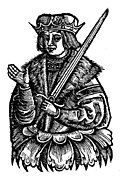
|
c. 8th century Son of Krakus I, brother of Krakus II |
Unknown | c. 8th century | Succession | Lechites (Tribe) |
| Wanda also Wąda c. 8th century |
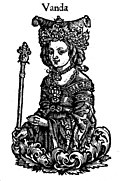
|
c. 8th century Daughter of Krakus, sister of Krakus II and Lech II |
Unknown | c. 8th century | Succession | Lechites (Tribe) |
| Duke Leszko I also Leszek c. 7th centuries – c. 8th centuries |

|
c. 7th centuries – c. 8th centuries |
Unknown | c. 7th centuries[4] – c. 8th centuries |
Birth name Przemysław, defeated the Hungarians and was crowned Elected |
Goplans and Polans (Tribes) |
| Duke Leszko II c. 8th century |

|
c. 8th centuries Presumed son of Leszko I, Alleged progenitor of the Popielids dynasty |
Unknown | c. 8th centuries | Succession | Popielids |
| Duke Leszko III c. 8th century |

|
c. 8th centuries Presumed son of Leszko II |
Unknown | c. 8th centuries | Succession | Popielids |
| Duke Popiel I c. 8th century |

|
c. 8th centuries Presumed son of Leszko III |
Unknown | c. 8th centuries | Succession | Popielids |
| Duke Popiel II c. 9th century |

|
c. 9th century Presumed son of Popiel I |
(1) NN, A German Princess | c. 9th century | A legendary ruler dethroned by Piast. He appears (without the number) in the oldest Polish chronicle, Gesta principum Polonorum from the early 12th century Succession |
Popielids |
| Piast the Wheelwright c. 9th century |

|
c. 9th century Son of Chościsko |
(1) Rzepicha | c. 9th century | Legendary founder of the Piast dynasty. He appears in the oldest Polish chronicle, Gesta principum Polonorum from the early 12th century | Piast |
Debatable rulers
[edit]The three direct predecessors of Mieszko I are known only from the account of Gallus Anonymus, who wrote the oldest Polish chronicle, Gesta principum Polonorum at the beginning of the 12th century. Though their historicity was once debatable, now historians tend to consider them actually existing rulers.[5]
| Name | Portrait | Birth | Marriage(s) | Death | Claim | House | Ref. |
|---|---|---|---|---|---|---|---|
| Duke Siemowit also Ziemowit 9th century |

|
9th century Presumed son of Piast the Wheelwright and Rzepicha |
Unknown | 9th century | Named the Duke of the Polans after his father, Piast the Wheelwright, refused to take the place of legendary Duke Popiel Elected |
Piast | [6] |
| Duke Lestek also Leszek or Lestko 9th century – 10th century |

|
c. 870–880 Presumed son of Siemowit |
Unknown | c. 930–950 | Named the Duke of the Polans after succeeding his father Succession |
Piast | [7][8] |
| Duke Siemomysł also Ziemomysł Latin: Zemomislaus 10th century – c. 950/960 |

|
c. 900 Presumed son of Lestek |
Unknown | c. 950–960 | Named the Duke of the Polans after succeeding his father Succession |
Piast | [9] |
House of Piast
[edit]Mieszko I started his reign as leader of Polans tribe, while other parts of future Poland were settled by other tribes, such as Masovians, Vistulans, Lendians, Silesians or Pomeranians. During his reign Mieszko united polish lands and adopted Christianity connecting Poland with western Europe. His descendents ruled the state as natural lords and Poland was seen as their hereditary property. Because of that, the state was often divided between sons of deceased ruler and eventually united by one of them. Early polish rulers were not considered equal to western European kings, so their title is translated as a duke. Some of them managed to prepare a coronation and adopted title of king, but effects of those efforts were short lived.
| Name | Portrait | Birth | Marriage(s) | Death | Claim | House |
|---|---|---|---|---|---|---|
| Duke Mieszko I Latin: Misico, dux Wandalorum c. 960 – 25 May 992 (31–32 years) |

|
c. 930 Son of semi-legendary Siemomysł |
(1) Doubravka of Bohemia c. 965 1 child (2) Oda of Haldensleben c. 980 3 or 4 children |
25 May 992 Poznań Aged about 62 |
First Christian ruler of Poland Succession |
Piast |
| King Bolesław I the Brave also Boleslaus I the Great Polish: Bolesław I Chrobry (Wielki) 992–1025 (as duke) 18 April 1025–17 June 1025 (as king) (32–33 years) |

|
c. 967 Poznań Son of Mieszko I and Doubravka of Bohemia |
(1) Hunilda, daughter of Rikdag (2) Judith of Hungary (3) Emnilda of Lusatia (4) Oda of Meissen |
17 June 1025 Kraków Aged about 58 |
First crowned king Succession |
Piast |
| King Mieszko II Lambert 25 December 1025–1031 (5–6 years) |

|
c. 990 Son of Bolesław I the Brave and Emnilda of Lusatia |
(1) Richeza of Lotharingia, 4 children | 10/11 May 1034 Poznań Aged about 44 |
Crowned king Succession Deposed by Bezprym |
Piast |
| Duke Bezprym 1031–1032 (0–1 years) |

|
c. 986 Son of Bolesław I the Brave and Judith of Hungary |
Unknown | c. 1032 Aged about 46 |
Usurped | Piast |
| Duke Otto 1032–1033 (0–1 years) |

|
c. 1000 Son of Bolesław I the Brave and Emnilda of Lusatia |
Unknown | c. 1033 Aged about 33 |
Country divided, ruler of a Duchy | Piast |
| Duke Dytryk also Dietrich and Theoderick 1032–1033 (0–1 years) |

|
c. 992 Son of Lambert Mieszkowic or Mieszko Mieszkowic |
Unknown | c. 1033 Aged about 41 |
Country divided, ruler of a Duchy | Piast |
| Duke Mieszko II Lambert 1032–1034 (1–2 years) |

|
c. 990 Son of Bolesław I the Brave and Emnilda of Lusatia |
(1) Richeza of Lotharingia, 4 children | 10/11 May 1034 Poznań Aged about 44 |
Country divided until 1033 Restored as duke |
Piast |
| King Bolesław the Forgotten Polish: Bolesław Zapomniany 1034–1038/1039 (4–5 years) |

|
before 1016 Presumed son of Mieszko II Lambert |
Unknown | 1038/1039 | Semi-legendary, existence disputed | Piast |
| Duke Casimir I the Restorer Polish: Kazimierz I Odnowiciel 1034/1040–1058 (17–18 years) |

|
25 July 1016 Son of Mieszko II Lambert and Richeza of Lotharingia |
(1) Maria Dobroniega, 5 children | 19 March 1058 Poznań Aged 41 |
Made prince in 1034, returned from abroad in 1040 Restoration |
Piast |
| King Bolesław II the Generous Polish: Bolesław II Szczodry (Śmiały) 1058–1076 (as duke) 26 December 1076–1079 (as king) (20–21 years) |

|
1042 Son of Casimir I the Restorer and Maria Dobroniega |
(1) Wyszesława, 1 son | 2/3 April 1081 Hungary or Ossiach Aged about 39 |
Crowned king in 1076 Deposed and exiled in 1079 after slaying Saint Stanislaus |
Piast |
| Duke Władysław I Herman 1079–4 June 1102 (22–23 years) |

|
1044 Son of Casimir I the Restorer and Maria Dobroniega |
(1) Przecława (2) Judith of Bohemia (3) Judith of Swabia |
24 June 1102 Płock Aged about 58 |
Succeeded brother after his exile | Piast |
| Duke Zbigniew 1102–1107 (4–5 years) |

|
c. 1073 Son of Władysław I Herman and Przecława (?) |
Unknown | 8 July 1113 Aged about 40 |
Country divided, ruler of a Duchy Succession |
Piast |
| Duke Bolesław III Wrymouth also Boleslaus III Polish: Bolesław III Krzywousty 1102–1138 (35–36 years) |

|
20 August 1086 Płock Son of Władysław I Herman and Judith of Bohemia |
(1) Zbyslava of Kiev (2) Salomea of Berg |
28 October 1138 Sochaczew Aged 52 |
Country divided until 1107 Succession His death led to the fragmentation of Poland |
Piast |
Fragmentation of Poland (1138–1320)
[edit]After period of fights between brothers and unstable inheritance Bolesław III Wrymouth decided to formalize succession. According to his testament the state was divided into provinces - one for every son and Senioral Province with capital city – Kraków. The testament established two principles on which new order in Poland was based - principate and seniorate. According to principate one duke - princeps (also called in English high duke) had supreme authority over other dukes and ruled in senioral province. According to seniorate princeps should be the oldest member of the dynasty, not necessarily son of the predecessor. During time of feudal fragmentation, as this period is called, both principles were abolished. Seniorate was formally abolished in 1180 during assembly of dukes and bishops in Łęczyca, where Casimir II the Just was made hereditary high duke. Principate was de facto abolished in 1227 with assassination of Leszek the White, after which local dukes no longer respected suzereinity of high duke, whose title became only prestigious.
| Name | Portrait | Birth | Marriage(s) | Death | Claim | House |
|---|---|---|---|---|---|---|
| High Duke Władysław II the Exile Polish: Władysław II Wygnaniec 1138–1146 (7–8 years) |

|
1105 Kraków Son of Bolesław III Wrymouth and Zbyslava of Kiev |
(1) Agnes of Babenberg, 5 children | 30 May 1159 Altenburg Aged 54 |
Succession Deposed and exiled |
Piast |
| High Duke Bolesław IV the Curly Polish: Bolesław IV Kędzierzawy 1146–1173 (26–27 years) |

|
c. 1125 Son of Bolesław III Wrymouth and Salomea of Berg |
(1) Viacheslava of Novgorod, 3 children | 5 January 1173 Aged about 51 |
Succeeded exiled half-brother | Piast |
| High Duke Mieszko III Polish: Mieszko III Stary 1173–1177 (3–4 years) |

|
c. 1127 Son of Bolesław III Wrymouth and Salomea of Berg |
(1) Elisabeth of Hungary (2) Eudoxia of Kiev |
13 March 1202 Kalisz Aged about 75 |
Succession Deposed by brother in 1177 |
Piast |
| High Duke Casimir II the Just Polish: Kazimierz II Sprawiedliwy 1177–1191 (13–14 years) |

|
c. 1138 Son of Bolesław III Wrymouth and Salomea of Berg |
(1) Helen of Znojmo, 7 children | 5 May 1194 Kraków Aged about 56 |
Usurped power from brother | Piast |
| Mieszko III 1191–1191 |

|
– | – | – | Usurped | Piast |
| Casimir II the Just 1191–1194 |

|
– | – | – | Restoration | Piast |
| High Duke Leszek I the White Polish: Leszek Biały 1194–1198 (3–4 years) |

|
c. 1184/1185 Son of Casimir II the Just and Helen of Znojmo |
(1) Grzymisława of Luck, 2 children | 24 November 1227 Marcinkowo Górne Aged about 43 |
Succession | Piast |
| Mieszko III 1198–1199 |

|
– | – | – | Agreement with Leszek and his regents | Piast |
| Leszek I the White 1199–1199 |

|
– | – | – | Restored | Piast |
| Mieszko III 1199–1202 |

|
– | – | – | Restored | Piast |
| High Duke Władysław III Spindleshanks Polish: Władysław III Laskonogi 1202–1206 (3–4 years) |

|
c. 1167 Son of Mieszko III and Eudoxia of Kiev |
(1) Lucia of Rügen, 2 children | 3 November 1231 Aged about 64 |
Invited to rule by voivode Mikołaj Gryfita | Piast |
| Leszek I the White 1206–1210 |

|
– | – | – | Restored | Piast |
| High Duke Mieszko IV Tanglefoot Polish: Mieszko IV Plątonogi 1210–1211 (0–1 years) |
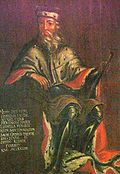
|
c. 1130 Son of Władysław II the Exile and Agnes of Babenberg |
(1) Ludmila, 5 children | 16 May 1211 Aged about 81 |
Usurped | Piast |
| Leszek I the White 1211–1227 (15–16 years) |

|
– | – | – | Restored Murdered in 1227 |
Piast |
| Władysław III Spindleshanks 1228–1231 |

|
– | – | – | Succession agreement with predecessor | Piast |
| High Duke Henry I the Bearded Polish: Henryk I Brodaty 1231–1238 (6–7 years) |

|
c. 1165/1188 Głogów Son of Bolesław I the Tall and Christina (?) |
(1) Hedwig of Andechs, 7 children | 19 March 1238 Krosno Odrzańskie Aged about 73 |
Succession agreement with predecessor | Piast |
| High Duke Henry II the Pious Polish: Henryk II Pobożny 1238–1241 (2–3 years) |

|
c. 1196 Głogów Son of Henry the Bearded and Hedwig of Andechs |
(1) Anne of Bohemia, 10 children | 9 April 1241 Legnickie Pole Aged about 45 |
Succession Killed at the Battle of Legnica |
Piast |
| High Duke Bolesław II the Horned Polish: Bolesław II Rogatka 1241–1241 |

|
c. 1220/1225 Głogów Son of Henry II the Pious and Anne of Bohemia |
(1) Hedwig of Anhalt, 7 children (2) Euphemia of Pomerania (3) Sophia of Dyhrn |
26 December 1278 Legnica |
Succession Deposed |
Piast |
| High Duke Konrad I of Masovia 1241–1243 (1–2 years) |

|
c. 1187/1188 Son of Casimir II the Just and Helen of Znojmo |
(1) Agafia of Rus, 10 children | 31 August 1247 Aged about 60 |
Usurped | Piast |
| High Duke Bolesław V the Chaste Polish: Bolesław V Wstydliwy 1243–1279 (35–36 years) |

|
21 June 1226 Stary Korczyn Son of Leszek I the White and Grzymisława of Luck |
(1) Kinga of Poland, no children | 7 December 1279 Kraków Aged 52 |
Restored as rightful Duke | Piast |
| High Duke Leszek II the Black Polish: Leszek Czarny 1279–1288 (8–9 years) |

|
c. 1241 Brześć Kujawski Son of Casimir I of Kuyavia and Constance of Wrocław |
(1) Gryfina of Halych | 30 September 1288 Kraków Aged about 47 |
Adopted by predecessor Succession |
Piast |
| High Duke Henryk IV Probus English: Henry the Righteous Polish: Henryk IV Prawy 1288–1290 (8–9 years) |

|
c. 1257/1258 Son of Henry III the White and Judith of Masovia |
(1) Constance of Opole (2) Matilda of Brandenburg |
23 June 1290 Wrocław Aged about 32 |
Usurped | Piast |
Attempt at restoration (1295–1296)
[edit]In XIII c. the idea of reunification of Poland under single ruler started to gain popularity. It was often connected with coronation and establishment of hereditary kingdom. First attempts were made by Henry II the Pious and Henry Probus but both of them died before they manage to achieve their goals. First duke, who became king in this period was Przemysł II. He ruled briefly as high duke but didn't manage to unite polish lands. He crowned himself when ruling in his hereditary province - Greater Poland and in province of Eastern Pomerania. His assassination in 1296 prolonged unification of Poland by 20 years.
| Name | Portrait | Arms | Birth | Marriage(s) | Death | Claim | House |
|---|---|---|---|---|---|---|---|
| King Przemysł II English: Premislaus II 1290–1291 (as High Duke) 1295–1296 (as King) (1 year) |

|

|
14 October 1257 Poznań Son of Przemysł I of Greater Poland and Elisabeth of Wrocław |
(1) Ludgarda of Mecklenburg (2) Richeza of Sweden (3) Margaret of Brandenburg |
8 February 1296 Rogoźno Aged 38 |
Named an heir in predecessors testament Crowned king in 1295 Granted Poland its coat of arms Assassinated |
Piast |
Přemyslid House
[edit]House of Přemyslid were natural lords of Bohemia and had many family connections with Piast dynasty. In 1291], Wenceslaus II of Bohemia exploited the weakness of internally divided Poland and conquered Kraków, basing his claim on loose family connection with one of the previous high dukes. He later legitimize his rule by marrying daughter of Przemysł II, which also gave him claims to Polish Kingdom.
| Name | Portrait | Arms | Birth | Marriage(s) | Death | Claim | House |
|---|---|---|---|---|---|---|---|
| King Wenceslaus II of Bohemia Polish: Wacław II Czeski 1291–1300 (as High Duke) 1300–1305 (as King) (4–5 years) |

|

|
27 September 1271 Prague Son of Ottokar II of Bohemia and Kunigunda of Slavonia |
(1) Judith of Habsburg (2) Elisabeth Richeza of Poland |
21 June 1305 Prague Aged 33 |
Usurped Crowned himself King of Poland in 1300 |
Přemyslid |
| (Uncrowned) Wenceslaus III of Bohemia Polish: Wacław III Czeski 1305–1306 (1 year) |

|

|
6 October 1289 Prague Son of Wenceslaus II and Judith of Habsburg |
(1) Viola of Teschen | 4 August 1306 Olomouc Aged 16 |
Succession Uncrowned and assassinated |
Přemyslid |
House of Piast (restored)
[edit]Near the end of the reign of Wenceslaus II his rule over Poland was undermined by remaining polish dukes - especially by Ladislaus the Short, who was exiled by Wenceslauss and had strong claim to inheritance of Przemysł II, and by Henry III of Głogów, who also was successor of Przemysł. Assassination of Wenceslaus III of Bohemia, which led to extinction of Přemyslid dynasty and succession crisis in Bohemia, left Poland for Wenceslaus opponents. His successors in Bohemia called themselves kings of Poland until Congress of Visegrád in 1335. Eventually Ladislaus the Short managed to unite two main provinces of Poland - Greater Poland and Lesser Poland and crowned himself king in 1320 ending the period of feudal fragmentation.
| Name | Portrait | Arms | Birth | Marriage(s) | Death | Claim | House |
|---|---|---|---|---|---|---|---|
| King Ladislaus the Short Polish: Władysław I Łokietek 1306–1320 (as High Duke) 20 January 1320 – 2 March 1333 (as King) (26 years, 183 days) |
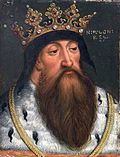
|

|
c. 1260 Son of Casimir I of Kuyavia and Euphrosyne of Opole |
(1) Jadwiga of Kalisz, 6 children | 2 March 1333 Kraków Aged about 73 |
Rebellion against Přemyslid rule Reunited the Kingdom of Poland after fragmentation Crowned King in 1320 |
Piast |
| King Casimir III the Great Polish: Kazimierz III Wielki 25 April 1333 – 5 November 1370 (37 years, 195 days) |

|

|
30 April 1310 Kowal Son of Władysław I the Elbow-high and Jadwiga of Kalisz |
(1) Aldona of Lithuania, 2 children (2) Adelaide of Hesse (3) Christina Rokiczana (4) Hedwig of Sagan, 3 children |
5 November 1370 Kraków Aged 60 |
Succession Strengthened Poland's position in Europe Died without a male heir Last monarch from the Piast Dynasty |
Piast |
House of Anjou
[edit]Casimir III the Great died without male heir. According to previous agreements his successor became his nephew, king of Hungary Louis I, beginning Polish-Hungarian personal union. After Louis death his kingdoms were separated - his younger daughter, Hedwig became king of Poland after brief interregnum (she is called king because in Poland title "queen" is reserved only for kings wife, not for sole ruler) and older daughter, Mary became queen of Hungary.
| Name | Portrait | Arms | Birth | Marriage(s) | Death | Claim | House |
|---|---|---|---|---|---|---|---|
| King Louis Polish: Ludwik Węgierski 17 November 1370 – 10 September 1382 (11 years, 298 days) |

|
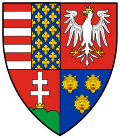
|
5 March 1326 Visegrád Son of Charles I of Hungary and Elizabeth of Poland |
(1) Margaret of Bohemia (2) Elizabeth of Bosnia, 4 children |
10 September 1382 Nagyszombat (Trnava) Aged 56 |
Succeeded his uncle, Casimir III, to the Polish throne | Anjou |
| King Hedwig Polish: Jadwiga 16 October 1384 – 17 July 1399 (14 years, 275 days) |

|

|
3 October 1373–18 February 1374 Buda Daughter of Louis I of Hungary and Elizabeth of Bosnia |
Władysław II Jagiełło (Jogaila), 1 child | 17 July 1399 Kraków Aged 25 |
Succeeded her father in Poland. The last hereditary ruler of Poland.[a] Her husband was crowned jure uxoris on 4 March 1386. |
Anjou |
House of Jagiellon
[edit]Female king Hedwig started her reign young and unmarried, which gave Poland a huge opportunity. She eventually married the pagan Grand Duke of Lithuania Jogaila, who adopted the name Władysław after baptism. This event led to the creation of the Polish-Lithuanian personal union. After Hedwigs death, Władysław remained king of Poland, but he and his successors were no longer considered natural lords of Poland and often had to give privileges to nobility in exchange for support of succession of their children.
| Name | Portrait | Arms | Birth | Marriage(s) | Death | Claim | House |
|---|---|---|---|---|---|---|---|
| King Władysław II Jagiełło Lithuanian: Jogaila 4 March 1386 – 1 June 1434 (48 years, 90 days) |

|

|
c. 1352/1362 Vilnius Son of Algirdas and Uliana of Tver |
(1) Hedwig of Poland (Jadwiga), 1 child (2) Anna of Cilli, 1 child (3) Elisabeth of Pilica (4) Sophia of Halshany, 3 children |
1 June 1434 Gródek Aged 72–82 |
Born a pagan Previously Grand Duke of Lithuania Crowned co-ruler with wife Hedwig Longest-reigning Polish monarch |
Jagiellon |
| King Władysław III English: Ladislaus III of Varna Polish: Władysław III Warneńczyk 25 July 1434 – 10 November 1444 (10 years, 109 days) |

|

|
31 October 1424 Kraków Son of Jogaila and Sophia of Halshany |
Unmarried and childless | 10 November 1444 Varna Aged 20 |
Elected as his father successor in Poland Killed at the Battle of Varna Interregnum until 1447 |
Jagiellon |
| King Casimir IV Polish: Kazimierz IV Jagiellończyk 25 June 1447 – 7 June 1492 (44 years, 349 days) |

|

|
30 November 1427 Kraków Son of Jogaila and Sophia of Halshany |
Elizabeth of Habsburg, 13 children | 7 June 1492 Grodno Aged 64 |
Election Previously Grand Duke of Lithuania Divided the Polish-Lithuanian realm between John and Alexander |
Jagiellon |
| King John I Albert Polish: Jan I Olbracht 23 September 1492 – 17 June 1501 (8 years, 268 days) |

|
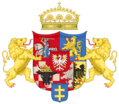
|
27 December 1459 Kraków Son of Casimir IV and Elizabeth of Habsburg |
Unmarried and childless | 17 June 1501 Toruń Aged 41 |
Elected as his father's successor in Poland Laid foundation for the Sejm and Senate (Polish Parliament) |
Jagiellon |
| King Alexander Polish: Aleksander Jagiellończyk 12 December 1501 – 19 August 1506 (4 years, 251 days) |

|

|
5 August 1461 Kraków Son of Casimir IV and Elizabeth of Habsburg |
Helena of Moscow | 19 August 1506 Vilnius Aged 45 |
Succeeded his brother in Poland as elective monarch Previously Grand Duke of Lithuania Buried in Lithuania |
Jagiellon |
| King Sigismund I the Old Polish: Zygmunt I Stary 8 December 1506 – 1 April 1548 (41 years, 116 days) |

|

|
1 January 1467 Kozienice Son of Casimir IV and Elizabeth of Habsburg |
(1) Barbara Zápolya, 2 children (2) Bona Sforza, 6 children |
1 April 1548 Kraków Aged 81 |
Succeeded his brother Lithuania, elected as his successor in Poland. | Jagiellon |
| King Sigismund II Augustus Polish: Zygmunt II August 18 December 1529 – 7 July 1572 (42 years, 203 days) |

|

|
1 August 1520 Kraków Son of Sigismund I and Bona Sforza |
(1) Elizabeth of Austria (2) Barbara Radziwiłł (3) Catherine of Austria |
7 July 1572 Knyszyn Aged 51 |
Election vivente rege Formation of the Polish–Lithuanian Commonwealth with an elective monarchy Last male member of the Jagiellonian Dynasty, died heirless |
Jagiellon |
Polish–Lithuanian Commonwealth, 1569–1795
[edit]In 1569, king Sigismund II Augustus, knowing that he had no heir, united Poland and Lithuania into single entity - the Polish-Lithuanian Commonwealth, to ensure that after his death both nations will remain under the same monarch. He also declared that after his death, the nobility would elect his successor, beginning the elective monarchy. He also ensured, that all nobles would decide the next king, not only the richest and most powerful ones. The first elective king - Henry of Valois signed the Henrician Articles, which guaranteed free elections and the rule of the nobility over the state. He, and every ruler after him, had to sign a 'pacta conventa' - a document of policies that the king promised to implement. After death of every king, an interregnum would be announced and the primate of Poland became an interrex; a temporary head of state, until a new king was elected.
| Name | Portrait | Arms | Birth | Marriage(s) | Death | Claim | House |
|---|---|---|---|---|---|---|---|
| King Henry Polish: Henryk Walezy 16 May 1573 – 12 May 1575 (1 year, 362 days) |

|

|
19 September 1551 Fontainebleau Son of Henry II and Catherine de' Medici |
(1) Louise of Lorraine, no children | 2 August 1589 Saint-Cloud Aged 37 |
Elected Left Poland in June 1574 to succeed his brother in France Interregnum until 1575 |
Valois |
| Queen Anna Polish: Anna Jagiellonka 15 December 1575 – 19 August 1587 (de facto) (11 years, 248 days) – 9 September 1596 (de jure) (20 years, 270 days) |

|

|
18 October 1523 Kraków Daughter of Sigismund I and Bona Sforza |
(1) Stephen Báthory, no children | 9 September 1596 Warsaw Aged 72 |
Elected co-monarch with Stephen Báthory Ruled only formally Sole ruler until Báthory's arrival and coronation in May 1576 Ruled after husband's death until her nephew was elected |
Jagiellon |
| King Stephen Báthory Polish: Stefan Batory 1 May 1576 – 12 December 1586 (10 years, 226 days) |

|

|
27 September 1533 Szilágysomlyó Son of Stephen Báthory of Somlyó and Catherine Telegdi |
(1) Anna Jagiellon, no children | 12 December 1586 Grodno Aged 53 |
Elected as co-monarch with Anna Jagiellon Prince of Transylvania |
Báthory |
| King Sigismund III Polish: Zygmunt III Waza 19 August 1587 – 30 April 1632 (44 years, 256 days) |

|

|
20 June 1566 Gripsholm Son of John III of Sweden and Catherine Jagiellon |
(1) Anne of Austria, 5 children (2) Constance of Austria, 7 children |
30 April 1632 Warsaw Aged 65 |
Elected, nephew of Anna Jagiellon Transferred capital from Kraków to Warsaw Hereditary King of Sweden until deposition in 1599 |
Vasa |
| King Władysław IV also Ladislaus IV Polish: Władysław IV Waza 8 November 1632 – 20 May 1648 (15 years, 195 days) |

|

|
9 June 1595 Łobzów Son of Sigismund III and Anne of Austria |
(1) Cecilia Renata of Austria, 3 children (2) Marie Louise Gonzaga |
20 May 1648 Merkinė Aged 52 |
Elective succession Also titular King of Sweden and elected Tsar of Russia (1610–1613) when the Polish army captured Moscow |
Vasa |
| King John II Casimir Polish: Jan II Kazimierz 20 November 1648 – 16 September 1668 (19 years, 302 days) |

|

|
22 March 1609 Kraków Son of Sigismund III and Constance of Austria |
(1) Marie Louise Gonzaga, 2 children (2) Claudine Françoise Mignot (morganatic marriage) |
16 December 1672 Nevers Aged 63 |
Elective succession, succeeded half-brother Previously a cardinal Titular King of Sweden Abdicated |
Vasa |
| King Michael I Polish: Michał Korybut Wiśniowiecki 19 June 1669 – 10 November 1673 (4 years, 145 days) |
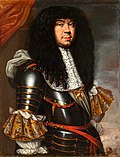
|

|
31 May 1640 Biały Kamień Son of Jeremi Wiśniowiecki and Gryzelda Konstancja Zamoyska |
Eleonora Maria of Austria, 1 child | 10 November 1673 Lwów Aged 33 |
Elected Born into nobility of mixed heritage, the son of a military commander and governor |
Wiśniowiecki |
| King John III Sobieski Polish: Jan III Sobieski 19 May 1674 – 17 June 1696 (22 years, 30 days) |

|

|
17 August 1629 Olesko Son of Jakub Sobieski and Teofila Zofia |
(1) Marie Casimire d'Arquien, 13 children | 17 June 1696 Wilanów Aged 66 |
Elected Born into nobility A successful military commander |
Sobieski |
| King Augustus II Polish: August II Mocny 15 September 1697 – 1706 (1st reign, 9 years) |
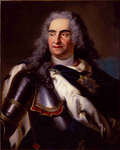
|
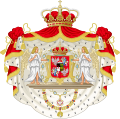
|
12 May 1670 Dresden Son of John George III and Princess Anna Sophie of Denmark |
(1) Christiane Eberhardine of Brandenburg-Bayreuth, 1 son by wife | 1 February 1733 Warsaw Aged 62 |
Elected Previously Elector and ruler of Saxony Dethroned by Stanislaus I in 1706 during the Great Northern War |
Wettin |
| King Stanislaus I Polish: Stanisław I Leszczyński 12 July 1704 – 8 July 1709 (1st reign, 4 years, 362 days) |
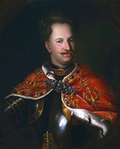
|

|
20 October 1677 Lwów Son of Rafał Leszczyński and Anna Jabłonowska |
(1) Catherine Opalińska, 2 children | 23 February 1766 Lunéville Aged 88 |
Usurped Nominated as ruler in 1704, crowned in 1705 and deposed predecessor in 1706 Exiled in 1709 |
Leszczyński |
| King Augustus II Polish: August II Mocny 8 July 1709 – 1 February 1733 (2nd reign, 23 years, 209 days) |

|

|
12 May 1670 Dresden Son of John George III and Princess Anna Sophie of Denmark |
(1) Christiane Eberhardine of Brandenburg-Bayreuth, 1 son by wife | 1 February 1733 Warsaw Aged 62 |
Restored | Wettin |
| King Stanislaus I Polish: Stanisław I Leszczyński 12 September 1733 – 26 January 1736 (2nd reign, 2 years, 137 days) |

|

|
20 October 1677 Lwów Son of Rafał Leszczyński and Anna Jabłonowska |
(1) Catherine Opalińska, 2 children, including Marie, Queen of France | 23 February 1766 Lunéville Aged 88 |
Elected His election sparked the War of the Polish Succession Deposed by Augustus III in 1736 |
Leszczyński |
| King Augustus III Polish: August III Sas 5 October 1733 – 5 October 1763 (30 years) |
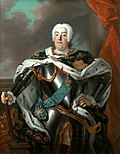
|

|
17 October 1696 Dresden Son of Augustus II the Strong and Christiane Eberhardine |
(1) Maria Josepha of Austria, 16 children, including Maria Josepha, Dauphine of France | 5 October 1763 Dresden Aged 66 |
Usurped Proclaimed King of Poland in 1733, crowned in 1734 Dethroned elected predecessor in 1736 |
Wettin |
| King Stanislaus II Augustus Polish: Stanisław II August 7 September 1764 – 25 November 1795 (31 years, 80 days) |

|

|
17 January 1732 Wołczyn Son of Stanisław Poniatowski and Konstancja Czartoryska |
Unmarried, had illegitimate children including with Empress Catherine II of Russia | 1 February 1798 Saint Petersburg Aged 66 |
Elected Born into nobility Last King of Poland and Grand Duke of Lithuania, his reign ended in the Partitions of Poland |
Poniatowski |
Duchy of Warsaw, 1807–1815
[edit]After long period of instability and anarchy, the Polish-Lithuanian Commonwealth was divided among its neighbours - Russia, Prussia and Austria. During the Napoleonic Wars, Napoleon created the Duchy of Warsaw from the lands of the Prussian partition. Some parts of Austrian partition were later added to the Duchy. The Duchy had its own duke and government, but was fully dependent on France. After the fall of Napoleon, the duchy was divided between Russia and Prussia.
| Name | Portrait | Arms | Birth | Marriage(s) | Death | Claim | House |
|---|---|---|---|---|---|---|---|
| Grand Duke Frederick Augustus I Polish: Fryderyk August I 9 June 1807 – 22 May 1815 (7 years, 348 days) |
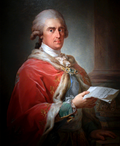
|

|
23 December 1750 Dresden Son of Frederick Christian, Elector of Saxony and Maria Antonia of Bavaria |
(1) Amalie of Zweibrücken-Birkenfeld, 1 daughter |
5 May 1827 Dresden Aged 76 |
Treaties of Tilsit Designated as a king of Poland by General Confederation of the Kingdom of Poland, 1812. |
Wettin |
Poland from 1815 to 1918
[edit]After fall of the Duchy of Warsaw, the Polish lands were reorganised. Prussia annexed Greater Poland and created the Grand Duchy of Posen, Kraków became a free city and the rest of the former Duchy of Warsaw became part of the Russian Empire, as Congress Poland. In 1846, Kraków was annexed by Austria and in 1848, the Grand Duchy of Posen was dissolved. In 1867, after the failed January Uprising, the remaining autonomy of Congress Poland was abolished. During World War I, in German occupied Congress Poland, the Regency Kingdom was formed and lasted from 1917 to 1918. After Poland regained independence in 1918, a republican system with the president as head of state was established.
See the list of rulers of partitioned Poland.
Family tree of the rulers of Poland
[edit]This is a family tree of the Kings of Poland.
Pretenders to the Polish throne
[edit]| History of Poland |
|---|
 |
|
Timeline of Polish history |
Modern
[edit]- Alexander, Margrave of Meissen (2012–), disputed[citation needed]
- Rüdiger, Margrave of Meissen (2012–2022), disputed
- Daniel, Margrave of Meissen (2022–), disputed.[11] Son of Rüdiger
Not recognized royal elections
[edit]- Maxmilian II Habsburg (1575–1576), See: 1576 Free election
- Maxmilian III Habsburg (1587–1589), See: 1587 Free election
- François Louis de Bourbon (1697), See: 1697 Free election
See also
[edit]- Monarchism in Poland
- Coronations in Poland
- Dukes of Greater Poland
- Dukes of Masovia
- Dukes of Pomerania
- Dukes of Sieradz-Łęczyca
- Dukes of Silesia
- Kings of Poland family tree
- List of rulers of Partitioned Poland
- List of Galician rulers
- List of heads of state of Poland
- List of Poles
- List of Polish consorts
- List of prime ministers of Poland
- Princely Houses of Poland
- List of Lithuanian monarchs
Notes
[edit]- ^ a b Throne of Poland was hereditary until 1399; Jadwiga was the last hereditary monarch, see Borkowska, Urszula (2012). Dynastia Jagiellonów w Polsce. PWN. ISBN 9788301205331. pp. 79, 481. "Jadwiga Anjou was considered the last 'naturally-enthroned Lady' of Kingdom of Poland. In Jagiellonian times in the politics of Corona Regni Poloniae persona of monarch became separated from country they were ruling. Throne became elective, although choice of the next ruler was restricted to the members of the [Jagiellonian] dynasty, until it had heirs." "Jadwiga (...) became a wife of Jagiełło, who was crown the King (...), as co-ruler alongside Jadwiga, the last hereditary monarch of Poland."
References
[edit]- ^ It was not allowed to use abbreviations and acronyms
- ^ In the 17th century and later Poland was usually known as the Most Serene Republic of Poland (Polish: Najjaśniejsza Rzeczpospolita Polska, Latin: Serenissima Res Publica Poloniae).
- ^ Henry Elliot Malden (4 July 2014). Salus Vienna Tua: The great siege of 1683. Soldiershop Publishing. pp. 79–. ISBN 978-88-96519-84-4.
- ^ dated around 700 by Marcin Bielski
- ^ Jasiński, Kazimierz (1992). Rodowód pierwszych Piastów. Wrocław-Warszawa. p. 46.
{{cite book}}: CS1 maint: location missing publisher (link) - ^ Janusz Roszko (1980). Kolebka Siemowita. Iskry. p. 170. ISBN 978-83-207-0090-9. Retrieved 29 February 2012.
- ^ Quaestiones Medii Aevi Novae. Wydawn. DiG. 2000.
- ^ Polski Indeks Biograficzny. Walter de Gruyter. 18 May 2012. ISBN 9783110947977.
- ^ Lukowski, Jerzy; Hubert Zawadzki (2006). A Concise History of Poland. Cambridge University Press. pp. 3–4. ISBN 978-0-521-61857-1.
- ^ "How prince Kiril could become king of Poland (in bulgarian)". bulgarianhistory.org. 13 June 2018. Retrieved 15 May 2021.
- ^ Pia Lucchesi (20 August 2017). "Prinz Daniel hat Prioritäten: Lieber Gemeinderat als König von Polen". TAG24. Retrieved 18 November 2021.
Bibliography
[edit]- Borkowska U., Dynastia Jagiellonów w Poslce, Warszawa 2012, ISBN 978-83-01-16692-2
- Duczmal M., Jagiellonowie. Leksykon biograficzny, Kraków 1996.
- Dybkowska A., Żaryn J., Żaryn M., Polskie dzieje. Od czasów najdawniejszych po współczesność, wyd. 2, Warszawa 1995. ISBN 83-01-11870-9
- Gierowski J.A., Rzeczpospolita w dobie złotej wolności (1648–1763), Kraków 2001. ISBN 83-85719-56-3
- Grodziski S., Polska w czasach przełomu (1764–1815), Kraków 2001. ISBN 83-85719-45-8
- Grodziski S., Porównawcza historia ustrojów państwowych, Kraków 1998. ISBN 83-7052-840-6
- Grzybowski S., Dzieje Polski i Litwy (1506–1648), Kraków 2000. ISBN 83-85719-48-2
- Maciorowski, Mirosław; Maciejewska, Beata (2018). Władcy Polski. Historia na nowo opowiedziana (in Polish). Warszawa: Agora. ISBN 978-83-268-2720-4.
- Morby J.E., Dynastie świata. Przewodnik chronologiczny i genealogiczny, Kraków 1995, s. 261–263. ISBN 83-7006-263-6
- Wyrozumski J., Dzieje Polski piastowskiej (VIII w.-1370), Kraków 1999. ISBN 83-85719-38-5
- Zientara B., Henryk Brodaty i jego czasy, wyd. 2, Warszawa 1997.
External links
[edit]- Górczyk, Wojciech. "Półksiężyc, orzeł, lew i smok. Uwagi o godłach napieczętnych Piastów" (in Polish). Histmag.org. June 14, 2009.
 KSF
KSF